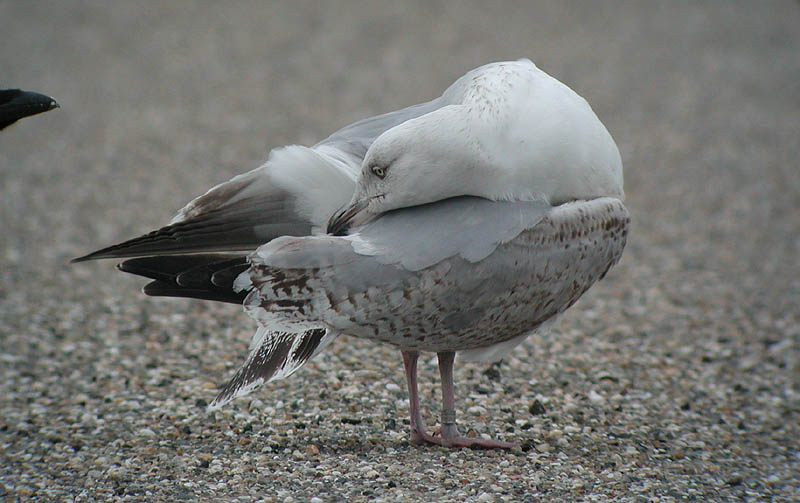 Herring
Gull - Zilvermeeuw (argentatus & argenteus): 4cy March
Herring
Gull - Zilvermeeuw (argentatus & argenteus): 4cy March
(last update: 31 januari 2005)
Home
Links
to Gull Sites
Gull Taxa
Gull Topography
Grey & Colour Charts
Locations in NW Europe
Summaries of Articles
About ORG
@
(3 images) Herring Gull 5.365.8464cy (argenteus), March 10 2004, Brouwersdam, the Netherlands (51.45N 03.52E). Pictures by Pim Wolf.
A 4cy argenteus,
ringed as pullus on July 07 2001 at Neeltje Jans, the Netherlands (51.37N 03.41E), Ringstation Arnhem 5.365.846.
This individual represents the immature-lloking Dutch 4cy argenteus
with plain adult-like
grey scapulars, strongly contrasting with the barred coverts,
creating a saddle effect. It also shows a pink-blue base to the
bill and a broad bill-band.
The
third generation primaries
have small white crescents and an obvious sharply demarcated mirror on P10.
The tail is completely third generation, showing a blackish band and basal
vermiculation.
The outer primary-covert are dark, unlike the grey adult-like primary-coverts of 5cy and older birds. Last autumn, so-called "third winter" birds (now 4cy by March) have replaced the clear immature primaries for more adult-like inner primaries (compare the inner primaries with this 3cy bird: H-113894). The size of the dark patches and the amount of black in the outer primaries is more extensive when compared to adults: there is often a broad dark sub-terminal band on P5 and a dark faint spot on the outer-web of P4. The dark patches are not sharply demarcated as in adult, but the dark outer-web gradually dissolves in the grey inner-web. Note the dark vermiculated markings on the tail-feathers in this individual.
From January to April, 4cy argenteus moult to so-called "third summer" plumage. By April, the head and under-parts will appear all-white. The tail-feathers, wing-coverts and primaries are not replaced, therefore most birds strongly resemble "third winter" birds, although the white primary tips wear away and dark patches start to bleach. The iris is often yellowish, the orbital ring yellowish-orange and the bill predominantly yellow with a red gonydeal spot and limited black markings along the culmen by April.


